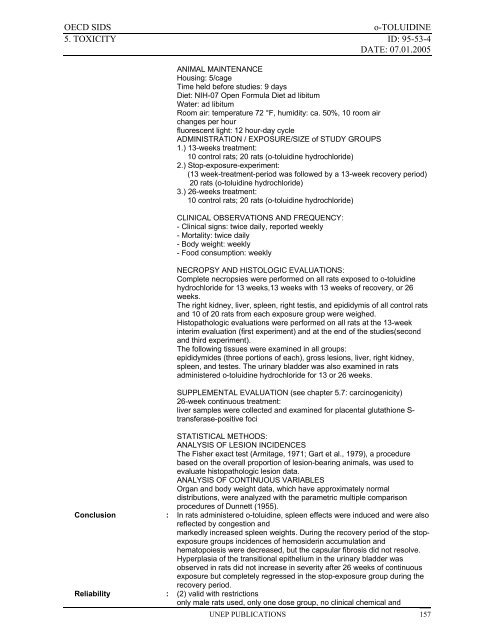o-TOLUIDINE CAS N°: 95-53-4 - UNEP Chemicals
o-TOLUIDINE CAS N°: 95-53-4 - UNEP Chemicals
o-TOLUIDINE CAS N°: 95-53-4 - UNEP Chemicals
Create successful ePaper yourself
Turn your PDF publications into a flip-book with our unique Google optimized e-Paper software.
OECD SIDS o-<strong>TOLUIDINE</strong><br />
5. TOXICITY ID: <strong>95</strong>-<strong>53</strong>-4<br />
DATE: 07.01.2005<br />
ANIMAL MAINTENANCE<br />
Housing: 5/cage<br />
Time held before studies: 9 days<br />
Diet: NIH-07 Open Formula Diet ad libitum<br />
Water: ad libitum<br />
Room air: temperature 72 °F, humidity: ca. 50%, 10 room air<br />
changes per hour<br />
fluorescent light: 12 hour-day cycle<br />
ADMINISTRATION / EXPOSURE/SIZE of STUDY GROUPS<br />
1.) 13-weeks treatment:<br />
10 control rats; 20 rats (o-toluidine hydrochloride)<br />
2.) Stop-exposure-experiment:<br />
(13 week-treatment-period was followed by a 13-week recovery period)<br />
20 rats (o-toluidine hydrochloride)<br />
3.) 26-weeks treatment:<br />
10 control rats; 20 rats (o-toluidine hydrochloride)<br />
CLINICAL OBSERVATIONS AND FREQUENCY:<br />
- Clinical signs: twice daily, reported weekly<br />
- Mortality: twice daily<br />
- Body weight: weekly<br />
- Food consumption: weekly<br />
NECROPSY AND HISTOLOGIC EVALUATIONS:<br />
Complete necropsies were performed on all rats exposed to o-toluidine<br />
hydrochloride for 13 weeks,13 weeks with 13 weeks of recovery, or 26<br />
weeks.<br />
The right kidney, liver, spleen, right testis, and epididymis of all control rats<br />
and 10 of 20 rats from each exposure group were weighed.<br />
Histopathologic evaluations were performed on all rats at the 13-week<br />
interim evaluation (first experiment) and at the end of the studies(second<br />
and third experiment).<br />
The following tissues were examined in all groups:<br />
epididymides (three portions of each), gross lesions, liver, right kidney,<br />
spleen, and testes. The urinary bladder was also examined in rats<br />
administered o-toluidine hydrochloride for 13 or 26 weeks.<br />
SUPPLEMENTAL EVALUATION (see chapter 5.7: carcinogenicity)<br />
26-week continuous treatment:<br />
liver samples were collected and examined for placental glutathione Stransferase-positive<br />
foci<br />
Conclusion :<br />
STATISTICAL METHODS:<br />
ANALYSIS OF LESION INCIDENCES<br />
The Fisher exact test (Armitage, 1971; Gart et al., 1979), a procedure<br />
based on the overall proportion of lesion-bearing animals, was used to<br />
evaluate histopathologic lesion data.<br />
ANALYSIS OF CONTINUOUS VARIABLES<br />
Organ and body weight data, which have approximately normal<br />
distributions, were analyzed with the parametric multiple comparison<br />
procedures of Dunnett (1<strong>95</strong>5).<br />
In rats administered o-toluidine, spleen effects were induced and were also<br />
reflected by congestion and<br />
markedly increased spleen weights. During the recovery period of the stopexposure<br />
groups incidences of hemosiderin accumulation and<br />
hematopoiesis were decreased, but the capsular fibrosis did not resolve.<br />
Hyperplasia of the transitional epithelium in the urinary bladder was<br />
observed in rats did not increase in severity after 26 weeks of continuous<br />
exposure but completely regressed in the stop-exposure group during the<br />
recovery period.<br />
Reliability : (2) valid with restrictions<br />
only male rats used, only one dose group, no clinical chemical and<br />
<strong>UNEP</strong> PUBLICATIONS 157
















